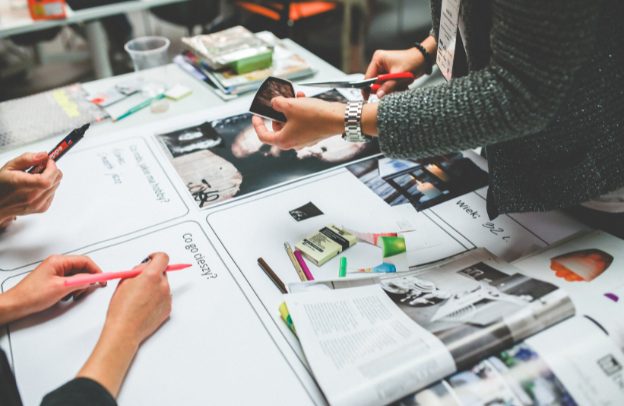The Beauty in Contradiction: Celebrating Differences and Unique Stories in the Creative Economy”

Are you looking to stand out? Dare to defy conformity and discover the power of embracing contradiction. In a world where many chase mainstream ideals for visibility, true success comes from standing apart. It’s at the crossroads of identity, culture, and experience that your unique story comes alive. By celebrating these contrasts, you’ll forge a brand that not only captivates your audience but also fuels your business growth.
Want to learn more about storytelling? Start by downloading the first chapter of The Storytelling Mastery.
As a creative entrepreneur, you hold the key to unlocking the power of storytelling. Your story is rich with the complexities of navigating different worlds, and it is precisely these intersections and contradictions that make it powerful.
In this article, we will explore how embracing the lines where contradictions meet can help you stand out in the creative economy, attract your ideal clients, and create lasting success.
Embracing Contradiction: The Core of Creative Storytelling
In the quest for business success, everyone is searching for that elusive angle—an advantage that sets them apart from the competition. But what if that angle lies not in conformity, but in the line of intersection and celebration of our differences?
There is beauty in contradiction, a call to explore the unique intersections of our identities, cultures, and experiences.
See also Entrepreneurial Spirit in the Diaspora: Lessons from Ikechukwu Micheal a Nigerian Barber in Italy
In an article by Alan Lewis and Dan McKone at the Harvard Business Review, they described the edges as follows: “the outer rim that frames what you do and separates it, quite conveniently, from what you don’t. Edges are frontiers beyond which something changes. When you proceed beyond this border in business, the main thing that changes is risk.”
Going further in the article, ‘When Opportunity Resides Along the Edges’, they added “Edges are not necessarily clear. To the contrary, many edges are quite fuzzy. When you look to the horizon, are you always sure where the sea ends and the sky begins? In business, strategy edges are like that too”
What about you? How do you see the edge in your attempt to stand out from the competition?
Now this is the point, instead of merely adhering to mainstream ideals, we should seek the edges where these contradictions reside. It’s in these spaces that innovation thrives, and authentic narratives emerge, allowing brands to connect deeply with their audiences.
By embracing the complexities of our stories, we can cultivate a distinct voice that not only resonates with consumers but also drives business growth.
For example, Nigerian-born fashion entrepreneur Amaka Osakwe, founder of Maki Oh, built her brand on the intersection of African aesthetics and global fashion trends. Rather than conform to Western ideals, Osakwe drew from her Nigerian heritage and infused her designs with traditional Nigerian symbols and techniques, creating a globally recognized brand.
Her story of fusing two worlds—African and international—became her strength, helping her stand out in the fashion industry and attract a global clientele.
Intersection as Opportunity: Where Roads Meet, Stories Flow
In the creative economy, intersections are where magic happens. When you look at your story through the lens of where different aspects of your life converge, you begin to uncover the most compelling narratives.
Whether it’s the intersection of cultures, experiences, or creative influences, these meeting points are gold mines for storytelling.
See also Navigating Change with Storytelling: How to Thrive in Evolving Markets
As an African diaspora entrepreneur, you’re in a unique position to tap into these intersections. You bring with you not only the richness of African culture but also the experiences of living and working in diverse global environments. This fusion allows you to tell stories that are both deeply personal and universally relatable.
African diaspora entrepreneurs have been increasingly focused on investing in Africa, particularly in the creative economy, where young Africans are driving innovation in sectors like fashion, music, film, and tech.
According to the African Development Bank, the African creative sector is growing at an annual rate of 5%, and the African diaspora plays a critical role in fueling this growth.
In 2020 alone, $83 billion in remittances were sent to Africa by diaspora communities, with a significant portion directed toward business investments and job creation in the creative economy.
Take the example of Iyinoluwa Aboyeji, the co-founder of Andela and Flutterwave, two companies that have significantly contributed to job creation and innovation in Africa’s tech ecosystem.
Aboyeji’s journey as a Nigerian entrepreneur educated in Canada and the U.S. exemplifies how intersections—between African needs and global resources—can drive growth.
By identifying where his expertise met Africa’s tech needs, Aboyeji was able to build a story and a business model that attracted investment and created opportunities for thousands of African developers.
Turning Obstacles Into Narrative Strength
The road to entrepreneurial success is often paved with obstacles, but it’s these challenges that make your story compelling. Just as a river flows across obstacles, shaping and reshaping itself as it moves, your business journey can be one of resilience, adaptation, and growth.
The obstacles you’ve overcome—whether it’s navigating unfamiliar markets, dealing with cultural biases, or balancing financial constraints—are not things to hide but to highlight in your story.
By framing these obstacles as key parts of your journey, you allow potential clients to connect with you on a human level. They see not just the polished, successful version of your brand but the real, gritty process that led you there.
In fact, research shows that consumers are drawn to brands that are authentic and transparent about their struggles. A study by Cohn & Wolfe found that 91% of consumers would reward a brand for being authentic by recommending it to others.
A great example of turning obstacles into narrative strength is Ade Hassan, founder of Nubian Skin, a lingerie brand created to provide nude underwear for women of color. Frustrated by the lack of options in the market, Hassan launched Nubian Skin in 2014 to fill the gap.
In the article, How This Founder Built A Business From A Viral Photo, available on Forbes.com, Hassan said to a Forbes contributor, Shani Syphrett “When we started, I only considered selling direct to consumer, but Asos approached us before we launched. They saw it as something that their buyers were waiting for. But I had no idea about wholesale, so I had to do a lot of Google researching and went in pretending to know what I was talking about.”
Like other entrepreneurs out there, Hassan admitted that she had “to figure out the logistics of going from having an idea to people buying into that idea to running a business.”
Today, her brand story is seen as built on the personal challenge of not finding products that catered to her skin tone, and she turned that obstacle into an opportunity. By addressing an unmet need and openly sharing her journey, she attracted a loyal customer base and gained widespread media attention.
The Power of Contrast in Brand Identity
Contrast is another powerful tool in storytelling. Just as contrasting colors or shapes in art make a piece more visually striking, contrasting elements in your story make your brand more memorable.
Whether you are blending traditional African influences with contemporary design, or fusing personal history with professional expertise, contrast creates a dynamic narrative that grabs attention.
As a creative entrepreneur, your story likely involves contrasts between your heritage and the demands of the modern marketplace. This contrast can be leveraged to create a distinctive brand identity that sets you apart from competitors.
See also Turning the Page: Storytelling Strategies that Render Competitors Invisible
Rather than trying to blend in, you can use contrast to your advantage, highlighting the unique aspects of your background that differentiate your brand.
For example, Bubu Ogisi, founder of IAMISIGO, an African fashion label, uses contrast masterfully in her designs and storytelling. She juxtaposes traditional African textile techniques with avant-garde fashion, creating a bold, innovative aesthetic that challenges conventional fashion norms.
This contrast not only defines her brand’s visual identity but also reflects her personal story of bridging African and global perspectives.
Crafting a Story That Resonates: Aligning with Client Values
Your story isn’t just about you; it’s also about your audience. To create a narrative that truly resonates, you need to understand your client’s desires, pain points, and values. The most effective storytelling occurs when your story aligns with what your clients care about.
This is especially true for purpose-driven entrepreneurs who want to attract clients with shared values. As the African diaspora increasingly turns to entrepreneurship, many are focused on using their businesses to address social, economic, or environmental issues in Africa.
According to the International Organization for Migration (IOM), African diaspora entrepreneurs are increasingly investing in sustainable development projects, from renewable energy to education, with an emphasis on job creation and innovation.
For example, Chinelo Anohu, a Nigerian-born financial expert and diaspora entrepreneur, has been instrumental in creating opportunities for African entrepreneurs through her work with the African Investment Forum.
By aligning her professional story with her mission to empower African businesses, Anohu has built a network that supports job creation and economic growth across the continent. Her story resonates with clients and investors who share her vision for Africa’s future, allowing her to attract partners who are aligned with her values.
The Future of Creative Entrepreneurship: Embracing Storytelling as a Business Tool
As the creative economy continues to evolve, storytelling remains one of the most powerful tools for differentiation and growth. In a world where consumers are bombarded with choices, your story is what sets you apart. It’s what makes you relatable, trustworthy, and memorable.
Social media and digital platforms have amplified the importance of storytelling in marketing. A survey by Sprout Social found that 68% of consumers want brands to be more transparent, and 61% are more likely to support businesses that tell authentic stories.
As a creative entrepreneur, you have the opportunity to use these platforms to share your story and build a loyal community around your brand.
The future of African diaspora entrepreneurship is bright. As more diaspora entrepreneurs invest in Africa’s creative economy, the potential for growth and job creation is immense.
See also How Diaspora Businesses Can Leverage African Talent in the Global Creative Economy
Conclusion on The Beauty in Contradiction
According to the United Nations, Africa’s population is expected to double by 2050, with over 60% of the population under the age of 25. This demographic shift presents a unique opportunity for diaspora entrepreneurs to invest in Africa’s young, creative workforce and drive innovation in industries ranging from fashion to tech.
As you move forward on your entrepreneurial journey, remember that the beauty lies in the contradictions. Don’t shy away from the complexities and intersections of your story—embrace them.
Seek out the places where your road meets the road of your clients and let your story flow from there. By doing so, you’ll not only build a brand that stands out but also create a business that resonates deeply with the people who matter most: your ideal clients.
Want to learn more about storytelling? Start by downloading the first chapter of The Storytelling Mastery.






